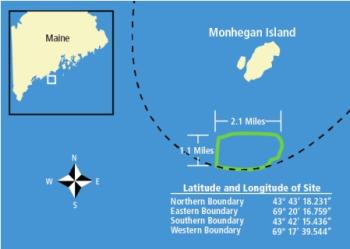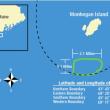State, private interests push forward siting wind power platform off of Monhegan
Private companies are working with the University of Maine to engineer and erect a demonstration offshore wind power platform two miles south of Monhegan Island in the Gulf of Maine. Proponents of the project are pledging coexistence with “traditional marine activities” as the project targets a 2023 completion.
Collaborating with UMaine in this latest effort to develop floating offshore wind technology demonstration project in the Gulf of Maine is New England Aqua Ventus, LLC, itself a joint venture between Diamond Offshore Wind Development, based in Los Angeles, California, and itself a subsidiary of the Mitsubishi Corporation, and RWE Renewables, based in Germany.
The project has been partially funded by the federal Department of Energy with $ 7 million. According to the DOE, the project is eligible for up to $37 million in additional funding in future project performance periods after reaching specific milestones, and subject to DOE progress reviews.
Diamond Offshore Wind and RWE Renewables will also invest $100 million to build the project and help demonstrate the technology at full scale, according to an Aug. 5 UMaine news release. NEAV is to involve Maine companies in permitting, construction and assembly, deployment, and ongoing operations and maintenance of the project, the release said.
And, NEAV committed to working with the University of Maine on research, development and design to take the technology elsewhere in the U.S. and the world. The concrete hulls are designed to be built in communities adjacent to potential projects, generating local construction jobs and other benefits during the building and assembly phase, UMaine said.
This particular wind power initiative has been under federal environmental review (National Environmental Policy Act) since 2017, according to the DOE.
In 2019, the Maine Public Utilities Commission approved and Central Maine Power signed the project’s 20-year Power Purchase Agreement, allowing the demonstration project to sell its electricity to the Central Maine Power utility, according to the DOE.
“As the developer, NEAV will own and manage all aspects of permitting, construction and assembly, deployment and ongoing operations for the project,” the university said. “UMaine’s Advanced Structures and Composites Center will continue with design and engineering, research and development and post-construction monitoring.”
"We are going to talk with coastal communities, the fishing industry, and others who are interested in the demonstration project,” said Chris Wissemann, CEO of Diamond Offshore Wind Development, a subsidiary of Diamond Generating Corporation, based in Los Angeles, California, and itself a subsidiary of Mitsubishi Corporation. “We have already begun to reach out and hope to have conversations very soon.”
To that end, the company has engaged Rep. Genevieve McDonald, D-Stonington, as its fisheries liaison. McDonald represents Cranberry Isles, Deer Isle, Frenchboro, Isle au Haut, North Haven, Southwest Harbor, Stonington, Swan's Island, Tremont and Vinalhaven, plus the unorganized territory of Marshall Island Township.
“As this project moves forward it’s imperative the fishing industry has a seat at the table,” said McDonald, on Aug. 10. “I am looking forward to coordinating stakeholder engagement.”
“We really appreciate her insights and encourage fishermen to reach out to her,” said Wissemann. “We are advocates of starting small, researching how offshore wind and fisheries can co-exist. We look forward to working with fishermen to see how offshore wind could be optimized to limit its impact on fisheries. This demonstration project should be considered to be a laboratory for people to see what an offshore wind turbine looks like up close."
The project is to consist of a single semisubmersible concrete floating platform that will support a commercial 10–12 megawatt wind turbine and will be set in a state-designated area two miles south of Monhegan Island and 14 miles from the mainland (see box for coordinates).
The purpose of the demonstration project is to further evaluate the floating technology, monitor environmental factors and develop best practices for offshore wind to coexist with traditional marine activities. The goal is to supply clean, renewable electricity to the Maine grid.
Sens. Susan Collins and Angus King and Reps. Chellie Pingree and Jared Golden issued a joint statement on the partnership announcement: “For generations, Maine has been a national leader when it comes to using our natural resources sustainably to create jobs, protect our environment and power our economy. The University of Maine’s floating deepwater offshore wind project carries on that tradition. We have strongly supported UMaine’s development of the Aqua Ventus project. We are proud to see the project’s progress and applaud the $100 million public-private partnership launched today, which will accelerate UMaine’s development of its innovative technology and create jobs. Maine’s offshore wind resource potential is 36 times greater than the state’s electricity demand, making this project so significant for Maine’s clean energy future.”
“Diamond Offshore Wind and RWE Renewables bring global expertise in offshore wind project development and construction, and we look forward to working with them to demonstrate UMaine’s floating hull technology in Maine waters,” said Habib Dagher, executive director of UMaine’s Advanced Structures and Composites Center, where the VolturnUS hull technology was invented. “Our design is ideally suited for deepwater deployment anywhere and has the potential to play a significant role in global efforts to decrease dependence on fossil fuels.”
“We are pleased to see the University of Maine continuing to make progress and that new private sector partners recognize the great potential of this project,” said Daniel Simmons, assistant secretary of energy efficiency and renewable energy for the U.S. Department of Energy. “This complements the investment of research, development and demonstration funding from DOE to advance innovation in a floating design for offshore wind.”
The state is supporting the effort with a study of Searsport as a potential site to support and develop offshore wind.
Gov. Janet Mills also accepted the invitation for Maine to join the Bureau of Ocean Energy Management Gulf of Maine Intergovernmental Renewable Energy Task Force, along with New Hampshire and Massachusetts, which is charged with facilitating coordination related to renewable energy activities in federal waters in the Gulf of Maine.
“The strength of Maine’s economy, the preservation of our natural resources, the long-term health and well-being of our communities and of future generations depend in great part on our transitioning to clean energy and tackling the threat of climate change,” says Gov. Janet Mills. “This new public-private partnership joins world-class offshore wind developers and the University of Maine, and puts us on track to be home to the nation’s first floating offshore wind project, reflecting the major economic growth opportunity of the clean energy economy. I am pleased this project is moving forward, and encouraged by the partners’ strong commitment to work collaboratively with Maine fishermen to protect and support our traditional industries as we chart a greener future for our state.”
“This is a significant milestone for the University of Maine, the offshore wind research team and the state of Maine,” said UMaine President Joan Ferrini-Mundy. “As Maine’s research university, UMaine is continually advancing its broad land grant, sea and space grant mission. The path from fundamental research to economic realization is complex, and success takes incredible innovation, persistence and strategic partnerships. Many faculty, staff and students have participated in the development of this technology, and will continue to support the energy and marine economy as this project transitions to the private sector. This collaboration exemplifies our role and commitment to creating and supporting the future of Maine.”
The developers also will work with the University of Maine System, the Maine Community College System and Maine Maritime Academy to attract K–12 students to science, engineering and business programs, prepare college students and help to create a skilled workforce in Maine with the technical skills necessary to support offshore wind development and operation.
About the University of Maine and its Advanced Structures and Composites Center: Founded in 1865, the University of Maine is a land, sea and space grant institution. The flagship campus of the University of Maine System is Maine’s only public research university. This vibrant and dynamic university serves Maine, the nation, and the world through its teaching, research and public engagement mission. UMaine students come from every county in Maine, more than 49 other states and 70 countries. Moreover, its nationally and internationally recognized research and graduate programs have global impact and local relevance in diverse areas, ranging from the energy, environment, marine and forestry sectors, to community revitalization, cultural preservation and advances in human health.
The Advanced Structure and Composites Center (ASCC) is the largest research center at the University of Maine. Founded in 1996 through a National Science Foundation award, it is housed in a 100,000-square-foot laboratory with 250 employees and students. ASCC is focused on green energy and materials research, has over 500 clients and partners worldwide, and has received top international awards for its research. It is home to the Alfond W2 Wind-Wave Ocean Engineering Laboratory, as well as the second-largest wind blade testing facility in the U.S. In 2013, it deployed VolturnUS 1:8, the first grid-connected offshore wind turbine in the U.S.
About Diamond Offshore Wind: Diamond Offshore Wind (DOW) is a wholly owned subsidiary of Diamond Generating Corporation (DGC) and a wholly owned subsidiary of Mitsubishi Corporation (MC). It was formed by DGC to develop, own and operate offshore wind projects in the U.S. Building on MC’s success in the global offshore wind market and DGC’s deep experience and outstanding performance as a U.S. independent power producer, DOW is uniquely positioned to be a strong, long-term leader in the burgeoning U.S. market.
About RWE Renewables: RWE Renewables, the newest subsidiary of the RWE Group, is one of the world's leading renewable energy companies. With around 3,500 employees, the company has onshore and offshore wind farms, photovoltaic plants and battery storage facilities with a combined capacity of approximately 9 gigawatts. RWE Renewables is driving the expansion of renewable energy in more than 15 countries on four continents. For further growth a net investment budget of €5 billion is available until 2022. When adding in possible partnerships, the medium-term investment budget could reach up to €9 billion. The focus is on the Americas, the core markets in Europe and the Asia-Pacific region.
About Cianbro: Cianbro is a Maine-based, 100% employee-owned and fully diversified construction company operating in over 40 states, including its affiliated companies Starcon and A/Z Corp. Cianbro has operated continuously for over 70 years and is recognized as an industry leader in multiple markets across the United States.
In terms of the project, we are advocates of starting small, researching how offshore wind and fisheries can co-exist. We look forward to working with fishermen to see how offshore wind could be optimized to limit its impact on fisheries. This demonstration project should be considered to be a laboratory for people to see what an offshore wind turbine looks like up close."
Event Date
Address
United States
























